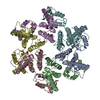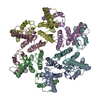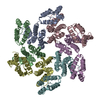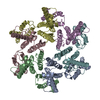+ Open data
Open data
- Basic information
Basic information
| Entry | Database: PDB / ID: 6vws | |||||||||
|---|---|---|---|---|---|---|---|---|---|---|
| Title | Hexamer of Helical HIV capsid by RASTR method | |||||||||
 Components Components | HIV capsid protein | |||||||||
 Keywords Keywords | VIRAL PROTEIN / Helical reconstruction / GS-6207 Hexamer HIV / RASTR | |||||||||
| Function / homology |  Function and homology information Function and homology informationviral budding via host ESCRT complex / host multivesicular body / ISG15 antiviral mechanism / viral nucleocapsid / viral translational frameshifting / host cell nucleus / host cell plasma membrane / virion membrane / structural molecule activity / RNA binding ...viral budding via host ESCRT complex / host multivesicular body / ISG15 antiviral mechanism / viral nucleocapsid / viral translational frameshifting / host cell nucleus / host cell plasma membrane / virion membrane / structural molecule activity / RNA binding / zinc ion binding / ATP binding / membrane Similarity search - Function | |||||||||
| Biological species |   Human immunodeficiency virus 1 Human immunodeficiency virus 1 | |||||||||
| Method | ELECTRON MICROSCOPY / helical reconstruction / cryo EM / Resolution: 6.08 Å | |||||||||
 Authors Authors | Zhao, H. / Iqbal, N. / Asturias, F. / Kvaratskhelia, M. / Vanblerkom, P. | |||||||||
| Funding support |  United States, 2items United States, 2items
| |||||||||
 Citation Citation |  Journal: Science / Year: 2020 Journal: Science / Year: 2020Title: Structural and mechanistic bases for a potent HIV-1 capsid inhibitor. Authors: Stephanie M Bester / Guochao Wei / Haiyan Zhao / Daniel Adu-Ampratwum / Naseer Iqbal / Valentine V Courouble / Ashwanth C Francis / Arun S Annamalai / Parmit K Singh / Nikoloz Shkriabai / ...Authors: Stephanie M Bester / Guochao Wei / Haiyan Zhao / Daniel Adu-Ampratwum / Naseer Iqbal / Valentine V Courouble / Ashwanth C Francis / Arun S Annamalai / Parmit K Singh / Nikoloz Shkriabai / Peter Van Blerkom / James Morrison / Eric M Poeschla / Alan N Engelman / Gregory B Melikyan / Patrick R Griffin / James R Fuchs / Francisco J Asturias / Mamuka Kvaratskhelia /  Abstract: The potent HIV-1 capsid inhibitor GS-6207 is an investigational principal component of long-acting antiretroviral therapy. We found that GS-6207 inhibits HIV-1 by stabilizing and thereby preventing ...The potent HIV-1 capsid inhibitor GS-6207 is an investigational principal component of long-acting antiretroviral therapy. We found that GS-6207 inhibits HIV-1 by stabilizing and thereby preventing functional disassembly of the capsid shell in infected cells. X-ray crystallography, cryo-electron microscopy, and hydrogen-deuterium exchange experiments revealed that GS-6207 tightly binds two adjoining capsid subunits and promotes distal intra- and inter-hexamer interactions that stabilize the curved capsid lattice. In addition, GS-6207 interferes with capsid binding to the cellular HIV-1 cofactors Nup153 and CPSF6 that mediate viral nuclear import and direct integration into gene-rich regions of chromatin. These findings elucidate structural insights into the multimodal, potent antiviral activity of GS-6207 and provide a means for rationally developing second-generation therapies. | |||||||||
| History |
|
- Structure visualization
Structure visualization
| Movie |
 Movie viewer Movie viewer |
|---|---|
| Structure viewer | Molecule:  Molmil Molmil Jmol/JSmol Jmol/JSmol |
- Downloads & links
Downloads & links
- Download
Download
| PDBx/mmCIF format |  6vws.cif.gz 6vws.cif.gz | 184.4 KB | Display |  PDBx/mmCIF format PDBx/mmCIF format |
|---|---|---|---|---|
| PDB format |  pdb6vws.ent.gz pdb6vws.ent.gz | 129.8 KB | Display |  PDB format PDB format |
| PDBx/mmJSON format |  6vws.json.gz 6vws.json.gz | Tree view |  PDBx/mmJSON format PDBx/mmJSON format | |
| Others |  Other downloads Other downloads |
-Validation report
| Summary document |  6vws_validation.pdf.gz 6vws_validation.pdf.gz | 768.1 KB | Display |  wwPDB validaton report wwPDB validaton report |
|---|---|---|---|---|
| Full document |  6vws_full_validation.pdf.gz 6vws_full_validation.pdf.gz | 771 KB | Display | |
| Data in XML |  6vws_validation.xml.gz 6vws_validation.xml.gz | 36.3 KB | Display | |
| Data in CIF |  6vws_validation.cif.gz 6vws_validation.cif.gz | 56.5 KB | Display | |
| Arichive directory |  https://data.pdbj.org/pub/pdb/validation_reports/vw/6vws https://data.pdbj.org/pub/pdb/validation_reports/vw/6vws ftp://data.pdbj.org/pub/pdb/validation_reports/vw/6vws ftp://data.pdbj.org/pub/pdb/validation_reports/vw/6vws | HTTPS FTP |
-Related structure data
| Related structure data |  21423MC  6vkvC M: map data used to model this data C: citing same article ( |
|---|---|
| Similar structure data |
- Links
Links
- Assembly
Assembly
| Deposited unit | 
|
|---|---|
| 1 |
|
- Components
Components
| #1: Protein | Mass: 24613.174 Da / Num. of mol.: 6 Source method: isolated from a genetically manipulated source Source: (gene. exp.)   Human immunodeficiency virus 1 / Gene: gag / Production host: Human immunodeficiency virus 1 / Gene: gag / Production host:  |
|---|
-Experimental details
-Experiment
| Experiment | Method: ELECTRON MICROSCOPY |
|---|---|
| EM experiment | Aggregation state: HELICAL ARRAY / 3D reconstruction method: helical reconstruction |
- Sample preparation
Sample preparation
| Component | Name: Hexamer of helical HIV capsid protein / Type: COMPLEX / Entity ID: all / Source: RECOMBINANT |
|---|---|
| Source (natural) | Organism:   Human immunodeficiency virus 1 Human immunodeficiency virus 1 |
| Source (recombinant) | Organism:  |
| Buffer solution | pH: 8 / Details: 1M NaCl, 50mM Tris pH 8.0 |
| Specimen | Conc.: 3 mg/ml / Embedding applied: NO / Shadowing applied: NO / Staining applied: NO / Vitrification applied: YES |
| Specimen support | Grid material: COPPER / Grid mesh size: 400 divisions/in. / Grid type: C-flat |
| Vitrification | Instrument: FEI VITROBOT MARK IV / Cryogen name: ETHANE / Humidity: 100 % / Chamber temperature: 298 K |
- Electron microscopy imaging
Electron microscopy imaging
| Experimental equipment |  Model: Talos Arctica / Image courtesy: FEI Company |
|---|---|
| Microscopy | Model: FEI TALOS ARCTICA |
| Electron gun | Electron source:  FIELD EMISSION GUN / Accelerating voltage: 200 kV / Illumination mode: FLOOD BEAM FIELD EMISSION GUN / Accelerating voltage: 200 kV / Illumination mode: FLOOD BEAM |
| Electron lens | Mode: BRIGHT FIELD / Nominal magnification: 28000 X / Calibrated magnification: 28000 X / Nominal defocus max: 2500 nm / Nominal defocus min: 1200 nm / Calibrated defocus min: 700 nm / Calibrated defocus max: 2000 nm / Cs: 2.7 mm / C2 aperture diameter: 50 µm / Alignment procedure: COMA FREE |
| Specimen holder | Cryogen: NITROGEN / Specimen holder model: FEI TITAN KRIOS AUTOGRID HOLDER / Temperature (max): 80 K / Temperature (min): 70 K |
| Image recording | Electron dose: 47.36 e/Å2 / Film or detector model: GATAN K3 (6k x 4k) / Num. of grids imaged: 4 / Num. of real images: 4246 |
| Image scans | Width: 5760 / Height: 4092 |
- Processing
Processing
| EM software |
| ||||||||||||||||||||||||||||||||||||||||||||||||||
|---|---|---|---|---|---|---|---|---|---|---|---|---|---|---|---|---|---|---|---|---|---|---|---|---|---|---|---|---|---|---|---|---|---|---|---|---|---|---|---|---|---|---|---|---|---|---|---|---|---|---|---|
| CTF correction | Type: NONE | ||||||||||||||||||||||||||||||||||||||||||||||||||
| Helical symmerty | Angular rotation/subunit: 150.32 ° / Axial rise/subunit: 7.61 Å / Axial symmetry: C1 | ||||||||||||||||||||||||||||||||||||||||||||||||||
| Particle selection | Num. of particles selected: 146291 Details: A total of 208,225helical segments were extracted from manually selected, well-ordered helical tubes using Relion | ||||||||||||||||||||||||||||||||||||||||||||||||||
| 3D reconstruction | Resolution: 6.08 Å / Resolution method: FSC 0.143 CUT-OFF / Num. of particles: 245050 / Algorithm: BACK PROJECTION Details: A non-helical approach (RASTR) to calculate a volume from the same subset of data used for helical analysis. The position and rotation to the center of a single hexamer in the final helical ...Details: A non-helical approach (RASTR) to calculate a volume from the same subset of data used for helical analysis. The position and rotation to the center of a single hexamer in the final helical volume was determined and used along the final refined helical rise and twist to extract a total of 245050 unique particles from which surrounding tube density was subtracted by reprojection using Relion. The resulting stack of 245050 particles, each extracted into a 192 multiple 192 pixel box centered around the chosen asymmetric unit for each subtracted volume, was imported into Cryosparc. 2D clustering and ab-initio heterogeneous reconstruction with 4 volumes were then used to select a subset of 96392 particle images. These images, along with the cleanest reference from ab-initio volume determination were then used to obtain a volume through 3D Refinement. Num. of class averages: 96392 / Symmetry type: HELICAL | ||||||||||||||||||||||||||||||||||||||||||||||||||
| Atomic model building | B value: 204.64 / Protocol: RIGID BODY FIT / Space: REAL | ||||||||||||||||||||||||||||||||||||||||||||||||||
| Atomic model building | PDB-ID: 6VKV Pdb chain-ID: A / Accession code: 6VKV / Pdb chain residue range: 1-220 / Source name: PDB / Type: experimental model |
 Movie
Movie Controller
Controller












 PDBj
PDBj

